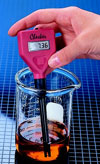|
Methods that may be used to measure pH. |
|
pH measurement
pH can be measured with:
- A pH meter
- Indicator solution
- Indicator paper
- Digital computer probe
A pH meter uses electrochemical methods to calculate the hydrogen ion concentration in a sample solution and convert it to pH on the instrument readout.
Indicators are many and varied both in chemical constitution and their colour responses to acids and bases. The indicators most commonly used are universal indicator, litmus, phenolphthalein and methyl orange.
|
Indicator
|
colour at pH 7
|
colour in acid
|
colour in base
|
| universal |
green
|
red
|
blue
|
| phenolphthalein |
colourless
|
colourless
|
red
|
| methyl orange |
yellow
|
red
|
yellow
|
Indicator paper
Indicator paper is simply absorbant paper containing either universal indicator (a mixture of pH sensitive dyes) or litmus (in the red or the blue form)
Realistically, the only indicator that gives even an approximate value for pH is universal, the others are useful for titrations or for performing spot tests to differentiate between acids and bases.
pH meters

pH meters work electronically by detecting the change in electrode potential of a glass electrode. Hand-held pH meters have improved immensely in recent years and provide a fast and easy means of measuring pH.
Most pH meters must first be calibrated using a buffer of known pH. Once the pH meter is calibrated correctly it may be used for direct measurement, rinsing with distilled water between each test.
Digital probes
Digital probes are now manufactured by many school suppiers and come complete with interface for connection to PCs and Macs. The advantage is that data is recorded automatically and pH curves may be plotted in real time.


